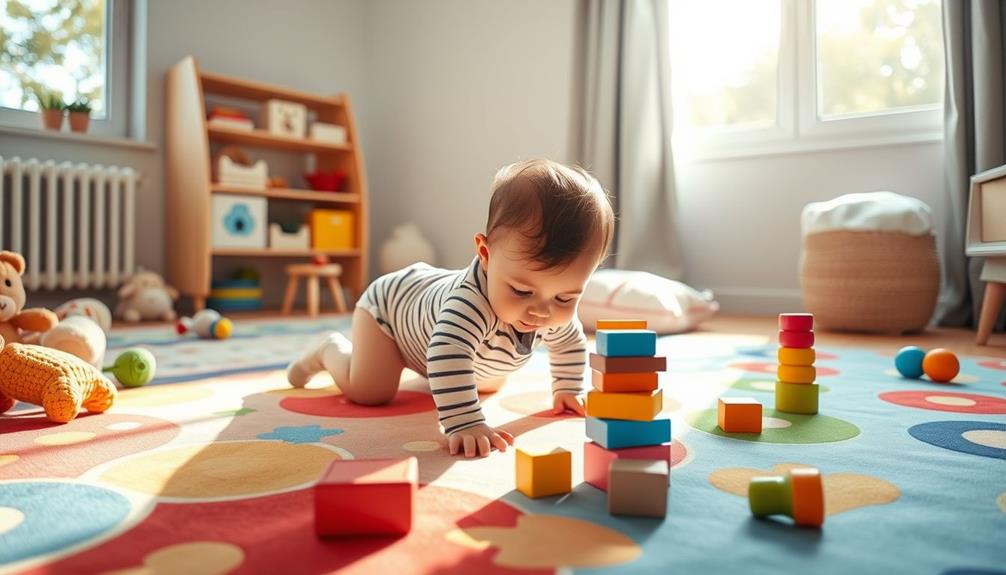Sending your mom heartfelt Italian birthday wishes is a wonderful way to celebrate her special day. You can say "Buon compleanno, mamma!" meaning "Happy birthday, mom!" or "Tanti auguri!" for "Many wishes!" If you want to express your love, try "Sei la migliore mamma del mondo!" which translates to "You're the best mom in the world!" For a sentimental touch, say "Grazie di esistere!" meaning "Thank you for existing!" These phrases convey warmth and affection, making her day even more special. Stick around, and you'll discover even more delightful wishes and traditions!
Key Takeaways
- "Buon compleanno, mamma!" translates to "Happy birthday, mom!"—a classic and heartfelt greeting for any birthday celebration.
- "Tanti auguri di cuore, mamma!" means "Many heartfelt wishes, mom!"—perfect for expressing love and warmth.
- "Spero che tu abbia un compleanno fantastico!" translates to "Hope you have a fantastic birthday!"—a cheerful wish for her special day.
- "Grazie di esistere, mamma!" means "Thank you for existing, mom!"—a touching way to show appreciation and love.
- "Cento di questi giorni!" translates to "100 more years!"—a wish for longevity and continued happiness in her life.
Classic Birthday Greetings
When it comes to celebrating your mom's special day, classic birthday greetings in Italian are a wonderful way to express your love and affection. You can start with "Buon compleanno," a simple yet heartfelt way to say "Happy Birthday."
Another great option is "Tanti auguri," which means "Many wishes." This phrase works perfectly for both formal and informal occasions, making it versatile for any birthday celebration. For a unique birthday experience, consider planning an island getaway that she'll cherish.
For a more festive note, you might choose "Felice compleanno," a common greeting you'll often find on cards. If you want to wish her even more joy, incorporating "cento di questi giorni!" adds a unique touch, meaning you wish her "100 more years!" of happiness.
To make your Italian birthday wishes even more special, consider using terms of endearment. Address her as "cara" (dear) or "mamma" (mom) to personalize your message.
You could say, "Cara mamma, Buon compleanno!" or "Tanti auguri, amica mia!" These heartfelt expressions will surely make her day brighter, showing her just how much you care.
Informal Birthday Wishes

When it comes to informal birthday wishes for your mom, you've got plenty of fun and heartfelt options. Phrases like "Tanti auguri, mamma!" and "Sei la migliore mamma del mondo!" add a personal touch that she'll cherish.
Additionally, a thoughtful message can strengthen your emotional connection, similar to how cats bond with their owners cats show signs of separation anxiety.
Let's explore some casual greetings and playful expressions that can make her special day even brighter!
Casual Birthday Greetings
Celebrating your mom's birthday can be a joyful occasion filled with heartfelt and casual greetings. You want to make her feel special and loved, and some informal wishes can do just that.
Here are a few casual greetings to take into account:
- Tanti auguri, mamma! – A simple yet warm way to say "Many wishes, mom!" that captures the essence of your love.
- Buon compleanno, cara mamma! – This translates to "Happy birthday, dear mom!" and adds a personal touch that she'll cherish.
- Spero che tu abbia un compleanno fantastico! – Meaning "Hope you have a fantastic birthday!" expresses your genuine wish for her happiness.
Don't forget to add some fun to the celebration! You might say, Festeggiamo con una torta deliziosa! which means "Let's celebrate with a delicious cake!" This emphasizes the joy of the occasion.
Or simply say, Ti voglio bene, mamma! Buon compleanno! to express your love while wishing her a happy birthday.
These casual greetings will surely bring a smile to her face and make her special day even brighter.
Heartfelt Wishes Examples
For a more personal touch, heartfelt informal birthday wishes can truly make your mom feel appreciated on her special day.
One sweet way to express your love is by saying, "Buon compleanno, mamma! Sei la luce della mia vita!" This translates to "Happy birthday, mom! You're the light of my life!" It's a beautiful reminder of how much she means to you.
You might also want to say, "Tanti auguri a te, la migliore mamma del mondo!" which means "Many wishes to you, the best mom in the world!" This shows her that you recognize her greatness.
Another touching message could be, "Spero che il tuo compleanno sia speciale come te!" translating to "I hope your birthday is as special as you!"
Don't forget to express your gratitude with, "Grazie di esistere, mamma! Ti voglio bene!" meaning "Thank you for existing, mom! I love you!"
Finally, wrap up your wishes with, "Ti auguro un meraviglioso compleanno pieno di amore e felicità!" which means "I wish you a wonderful birthday filled with love and happiness!"
These heartfelt wishes will surely make her day unforgettable.
Fun Phrases to Share
Birthday celebrations are all about joy and laughter, especially when it comes to your mom. You want to make her feel special with some fun, informal Italian birthday wishes. Here are three phrases you can share to bring a smile to her face:
- Tanti auguri di cuore, mamma! – This means "Many heartfelt wishes!" and shows your love in a warm way.
- Sei la mia gioia! – Translating to "You are my joy!" this phrase expresses your appreciation for all she does.
- Spero che tu abbia una giornata fantastica! – This means "I hope you have a fantastic day!" and conveys your hopes for her special day.
Wrap these heartfelt wishes with an extra touch of sweetness by adding, Buon compleanno, mamma! (Happy birthday, mom!) and Auguri per un anno pieno di felicità! (Wishes for a year full of happiness!).
These Italian birthday wishes are bound to make her birthday brighter and fill her heart with joy. So, go ahead and share these phrases to create unforgettable memories together!
Heartfelt Messages for Mom

A mother's birthday is a perfect opportunity to express your love and appreciation with heartfelt messages that resonate deeply. You can start with a warm "Buon compleanno, mamma! Sei la luce della mia vita," which means "Happy birthday, mom! You're the light of my life." This simple phrase captures how much she means to you.
Consider also how a clean and organized home can enhance the celebration, making for a more enjoyable day key factors in choosing a home cleaning service.
You might also want to express gratitude by saying, "Grazie di esistere, mamma! Ti voglio bene," translating to "Thank you for existing, mom! I love you." It's a beautiful way to show her how much you cherish her presence in your life.
To wish her many more joyful years, you could add, "Cento di questi giorni, cara mamma!" which means, "A hundred more of these days, dear mom!"
Don't forget to include a personal touch like, "Spero che tu abbia un compleanno fantastico, come te," meaning "I hope you have a fantastic birthday, just like you."
Writing a Birthday Card

When you're writing a birthday card for your mom, it's important to include meaningful messages that resonate with her. Incorporating elements like her favorite memories or traits can enhance the sentiment further, making her feel cherished.
You can also consider how astrology explores personality traits to personalize your wishes based on her zodiac sign. This will make your card not only heartfelt but also uniquely special for her day.
Meaningful Card Messages
Crafting a meaningful birthday card for your mom can truly express your love and appreciation.
To make your message stand out, consider including heartfelt phrases that resonate with her. Here are some ideas:
- Start with a warm greeting: Use "Buon compleanno, mamma!" to kick off your card. Follow it with "Sei la luce della mia vita," which translates to "You are the light of my life."
- Share your wishes: You might say, "Ti auguro un felice compleanno! Ogni anno con te è un regalo," meaning "I wish you a happy birthday! Every year with you is a gift." This emphasizes the joy she brings into your life.
- Express gratitude and love: Conclude with a loving note like, "Ti voglio bene, mamma! Festeggiamo insieme!" This means "I love you, mom! Let's celebrate together!" It wraps up your message with warmth and affection.
Personal Touch Ideas
Adding a personal touch to your birthday card can make your message even more memorable. Start with a heartfelt greeting like "Buon compleanno, mamma!" to set the tone.
Next, personalize your message by sharing a specific memory or quality you cherish about her. You might say, "Grazie di esistere!" to express your gratitude for having her in your life.
To convey your best wishes, include phrases like "Spero che tu abbia un compleanno fantastico!" This not only shows your love but also makes her feel cherished on her special day.
You can also reflect on a cherished moment you both share, like a fun trip or a cozy night in, to evoke warm feelings.
Wrap up your card with a warm closing, such as "Con tutto il mio amore," to reinforce your affection.
Finally, don't forget to sign your card with a loving touch, using "Il tuo [tuo nome]." This simple act can bring a smile to her face and remind her how much she means to you.
Unique Italian Birthday Traditions

In Italy, celebrating a birthday is steeped in unique traditions that create a festive atmosphere. As you prepare for your mom's special day, it's crucial to understand these customs that make Italian birthday traditions so special.
A vegan-friendly celebration can also be considered, incorporating delicious vegan alternatives to traditional dishes, guaranteeing everyone enjoys the festivities.
- Tanti Auguri: You'll hear the classic birthday song, "Tanti auguri a te," sung to celebrate the celebrant. It's common to personalize it with her name, making the moment even more special.
- Torta di Compleanno: The birthday person usually chooses their own cake, often opting for a rich "torta di compleanno" or a delicious "profiterole." This personal touch guarantees that the celebrant enjoys their favorite dessert.
- Tirare le Orecchie: A fun custom involves guests playfully pulling the birthday person's earlobes as many times as their age. This tradition adds a light-hearted element to the festivities.
Celebratory Songs and Activities

How do Italians make birthdays unforgettable? They infuse every celebration with warmth and joy, starting with the classic "Tanti auguri a te." This happy birthday song isn't just sung; it's personalized, turning each note into a heartfelt tribute to the birthday person.
As family and friends gather, they create a lively atmosphere filled with laughter and music, much like the way top-rated payment solutions enhance donor engagement during celebrations.
Integral to these birthday celebrations is the birthday cake. Guests enthusiastically await the moment when the candles are lit, ready to blow them out while making a wish—a tradition known as "spegnere le candeline." This act symbolizes hope and joy, making it a cherished part of the festivities.
Another highlight is the celebratory toast, or "brindisi di compleanno," where glasses filled with Prosecco are raised in honor of the birthday person. It's a beautiful way to express love and appreciation during special occasions.
To top it all off, expect games and dancing that embody the spirited essence of Italian culture. These elements come together to create a memorable celebration, ensuring that every birthday is a delightful experience filled with love and laughter.
Popular Birthday Phrases

Celebrating your mom's birthday in Italian style means using heartfelt phrases that truly convey your love and appreciation. Not only do these phrases reflect your feelings, but they also connect to the cosmic significance of expression and affection, as seen in astrological insights into personal confidence.
Here are some popular birthday phrases that will make her day extra special:
- "Buon compleanno, mamma!" – This classic greeting translates to "Happy birthday, mom!" It's a simple yet meaningful way to start her special day.
- "Tanti auguri di buon compleanno!" – Meaning "Many wishes for a happy birthday!" this phrase is perfect for expressing your warmest sentiments.
- "Spero che tu abbia un compleanno fantastico!" – This translates to "I hope you have a fantastic birthday!" It adds a personal touch, showing you care about her happiness.
Additionally, don't forget to express your gratitude with "Grazie di esistere!", which means "Thank you for being born!" This lovely sentiment can make her feel truly cherished.
Finally, you can wish her longevity with "Cento di questi giorni!", meaning "A hundred more of these days!"
These Italian birthday wishes and phrases will surely brighten her special day, filling it with love and joy.
Cultural Insights on Birthdays

Birthdays in Italy are vibrant occasions filled with joy and connection. When celebrating a birthday, you'll find that family gatherings are at the heart of the festivities. Italian traditions emphasize the importance of bringing loved ones together, often featuring festive meals that reflect the birthday person's preferences.
You'll commonly hear the song "Tanti auguri a te" sung, which is personalized with the name of the birthday person, adding a special touch to the celebration. Dogs are also part of the family in Italy, and many owners celebrate their pets' birthdays with equal enthusiasm, showcasing their love through unique dog names.
One interesting cultural insight is that it's customary for the birthday person to treat guests to food and drinks, showcasing the Italian norm of generosity during such occasions. You may also encounter playful customs like "tirare le orecchie," where guests pull the birthday person's earlobes according to their age, making the day even more memorable.
It's essential to wish someone a happy birthday on their actual day, as communal participation in expressing good wishes is a cherished tradition.
With these vibrant customs and heartfelt connections, an Italian birthday truly embodies love, joy, and community spirit. So, when it's your mom's special day, remember these cultural insights to enhance her celebration!
Italian Vocabulary for Birthdays

When you celebrate a birthday in Italy, knowing some key vocabulary makes all the difference.
You'll want to familiarize yourself with phrases like "Buon compleanno" and terms like "torta di compleanno" to enhance your greetings.
Additionally, similar to how coffee scrubs benefit skin care, understanding these expressions will help you connect better with your loved ones on their special day.
Essential Birthday Vocabulary
Italian birthdays are filled with joy and tradition, and knowing some essential vocabulary can enhance your experience. Here are a few key terms you should have in your repertoire:
- Torta di compleanno – This means "birthday cake," a must-have for any celebration. The cake is often beautifully decorated and may feature your mom's favorite flavors.
- Brindisi di compleanno – A "birthday toast" is a heartfelt moment during the festa di compleanno, where you raise a glass to honor the celebrant.
- Candelina – These are the small candles placed on the torta di compleanno, which your mom will blow out while making a wish.
Using these terms can help you express your wishes more warmly. For instance, you can say "Tanti auguri!" to convey your birthday greetings.
Don't forget to think about a thoughtful regalo di compleanno to make her day even more special. If you happen to be late, you can still say "auguri in ritardo" to let her know you're thinking of her.
Embracing this vocabulary will definitely make the celebration more meaningful!
Common Birthday Phrases
Celebrating your mom's birthday in Italy means you'll want to express your wishes using the right phrases. The most common way to wish her a Happy Birthday is by saying "Buon compleanno." It's simple yet heartfelt.
You can also use "Tanti auguri," which means "Many wishes" and works perfectly for any birthday greeting.
If you're looking to add a personal touch, try saying "Auguri di buon compleanno," meaning "Best wishes for a happy birthday." This phrase conveys your genuine feelings while celebrating her special day.
To express hopes for her longevity, say "Cento di questi giorni!" which translates to "100 more years!" This is a lovely sentiment that shows your desire for her to have many more birthdays ahead.
If you happen to miss the celebration, don't fret! Just say "Tanti auguri in ritardo," which means "Happy belated birthday." This way, you still honor her birthday even after the fact.
Using these common birthday phrases will surely make her feel cherished on her special day.
Traditional Birthday Expressions
Birthdays in Italy are all about heartfelt expressions, and knowing the right vocabulary can enhance the celebration. Whether you're celebrating your mom's special day or sending her wishes from afar, here are some traditional expressions that will surely brighten her birthday:
- Buon compleanno – This is the most common phrase for "Happy Birthday." You can make it more personal by adding "caro" (dear).
- Tanti auguri – Meaning "Many wishes," this is a favorite among friends and family during birthday festivities.
- Cento di questi giorni! – Use this unique expression to wish her longevity and happiness, translating to "100 more years!"
If you happen to miss her actual birthday, don't worry! You can say Tanti auguri in ritardo, which means "happy belated birthday."
On her special day, you'll likely enjoy a festa di compleanno with a delicious torta di compleanno and plenty of regali di compleanno.
Embracing these traditional expressions will make her birthday celebration even more memorable and heartfelt!
Engaging With Italian Culture

To truly immerse yourself in Italian culture, consider participating in local community events that celebrate its rich heritage. These events, like festivals and cuisine tastings, offer a fantastic opportunity to engage with Italian culture while making new Italian friends.
Additionally, exploring traditional artistic expressions, such as Aboriginal art concepts, can provide insights into the diverse cultural narratives around the world. As you explore, you'll discover the joys of traditional Italian dishes, enhancing your culinary skills and language journey as you read recipes and source ingredients.
Learning Italian can also be a fun experience through songs, films, and literature. These mediums not only improve your language skills but also deepen your understanding of societal values and historical contexts.
Additionally, seeking out cultural workshops can provide hands-on experiences that connect you with customs and traditions.
Don't forget to interact with native speakers via language exchange programs or social media. This engagement enriches your cultural insights and helps you grasp conversational nuances and idiomatic expressions.
Finally, exploring Italy's artistic heritage through museums or studying art history can further deepen your appreciation for the cultural contributions shaping modern Italian identity.
Embrace these experiences, and you'll find yourself celebrating every moment, including sending wishes of a happy birthday to your loved ones in Italian!
Frequently Asked Questions
How Do You Say Happy Birthday and Best Wishes in Italian?
To say "happy birthday" in Italian, you can use "Buon compleanno."
If you want to add best wishes, you might say "Tanti auguri," which means "many wishes."
For a more heartfelt greeting, try "Tanti auguri di buon compleanno!"
If you're celebrating joyfully, "Felice compleanno" works too.
And if you happen to miss a birthday, don't forget "Auguri in ritardo!" to express your belated wishes.
What Translates to Italian Best Wishes?
When you want to express "best wishes" in Italian, you can say "migliori auguri." This phrase captures your heartfelt sentiments perfectly.
If you're celebrating someone's special day, combining it with "buon compleanno" creates a warm greeting.
You might also consider personalizing your wishes with phrases like "ti auguro tanta felicità," meaning "I wish you much happiness."
Using these expressions will surely make your message more memorable and meaningful.
What Do Italians Write in Birthday Cards?
Have you ever wondered what heartfelt messages fill Italian birthday cards?
Italians often express warm wishes, sharing sentiments like "Buon compleanno!" and hopes for a year filled with love and happiness.
You might find phrases of gratitude, thanking loved ones for their unwavering support.
They often wish for health and joy, closing with affectionate phrases.
Including personal touches makes each card special, ensuring the recipient feels cherished on their special day.
What Is "Happy Birthday" in Italian for a Woman?
When you want to say "Happy Birthday" in Italian for a woman, you can use "Buon compleanno, cara!" This translates to "Happy Birthday, dear!"
For a more affectionate touch, try "Tanti auguri!" which means "Many wishes!"
If you're addressing your mom specifically, "Felice compleanno, mamma!" works perfectly.
Adding endearments like "bellissima" can make your wishes even more special, such as saying "Buon compleanno, bellissima!" to celebrate her beauty.
Conclusion
So, as you celebrate your mom's special day, don't forget to sprinkle in some heartfelt Italian wishes. Whether you choose a classic greeting or a more casual expression, your words will surely bring a smile. Embrace the beautiful traditions and unique phrases that make Italian culture so vibrant. Remember, it's not just about the cake and candles; it's about the love you share. After all, a birthday without a little pasta is like a modern life without Wi-Fi!










